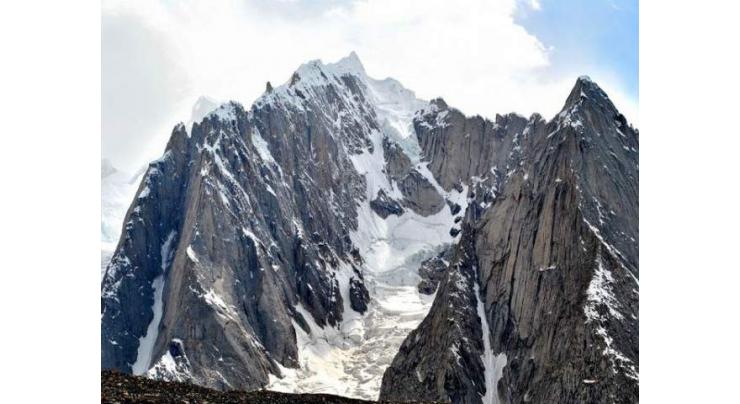
Mitigating Growing Risk Of Glacial Lakes Outbursts In Northern Area
Faizan Hashmi Published August 17, 2018 | 08:30 PM

The Ministry of Climate Change had conceived the idea of second phase of GLOF some two years ago and hammered out the project proposal in support with the United Nations Development Programme (UNDP).
ISLAMABAD, (UrduPoint / Pakistan Point News - 17th Aug, 2018 ) :The Ministry of Climate Change had conceived the idea of second phase of GLOF some two years ago and hammered out the project proposal in support with the United Nations Development Programme (UNDP).
This was said by the Media Director Ministry of Climate Change Muhammad Saleem while talking to APP here on Friday.
He said that mitigating the growing risks from the glacial lakes outbursts in the country's north Northern, implementation of the GLOF project's second phase is being mulled over with relevant stakeholders including Global Environment Facility (GEF), UNDP-Pakistan, Pakistan Meteorological Department, Pakistan Flood Commission, National and Provincial Disaster Management Authorities, community-based organsations, which will cover 15 districts of Gilgit-Baltistan and Khyper-Pakhtunkhwa, benefiting 29 million people.
The official highlighted that around 700,000 people will directly and about 30 million people will indirectly benefit from the project in many ways.
Spelling out the expected outcomes and benefits of the GLOF Phase � II, Mr. Saleem said that 95 percent of households in target communities in KPK and Gilgit-Baltistan areas will be able to receive and respond to early warnings about glacial lake outbursts and consequent floods in their areas and take the appropriate mitigation actions to save their lives and livelihoods.
It will address climate change impacts and Glacial Lake Outbursts Floods (GLOF) risks by preventing loss of lives and community infrastructure based on a holistic approach in all seven districts of Gilgit-Baltistan and five districts in Khyber-Pakhtunkhwa, thus, contributing to a climate-resilient sustainable development in the long-term.
Besides, 250 small-scale engineering structures will be established to reduce the effects of GLOF events on livelihoods, such as tree plantation, controlled drainage and mini dams, fifty weather monitoring stations will be set up in GLOF-vulnerable areas to gather meteorological data in catchment areas and 408 river discharge sensors will be put in place to obtain river flood data, the spokesperson added.
He further said that the measures would be also taken to enhance food security of the mountain communities in the country's northern regions and reduce flood-related hazards caused due to deforestation, landslides, land erosion and inefficient water use.
At least, 65,000 women would get training in home gardening and 240 water-efficient farming technologies would be set up and 35,000 hectares of land will be reforested to alleviate devastating impacts of GLOFs, the spokesperson highlighted.
He also highlighted that the project would also strengthen sub-national institutional capacities to plan and implement climate change and disaster-resilient development pathways as proposed outputs and activities will develop the capabilities of local level institutions and Federal level institutions to incorporate climate change adaptation considerations into development plans in G-B and K-P.
Talking about positive results of the first phase of the five-year $6.7 million GLOF project implemented in Bindo Gol valley of the Chitral District and Bagrot valley of Gilgit district, he said that the project helped vulnerable communities prepare for and mitigate GLOF risks through early warning systems, enhanced infrastructure and community-based disaster risk management, construct flood diversion walls around more than 10 vulnerable villages and establishment of flood early warning weather stations.
The project was implemented by the climate change ministry with generous funding and logistical support from the UN's Adaptation Fund, the United Nations DevelopmentProgramme (UNDP).
The media spokesperson Mohammad Saleem recalled, "When a glacial lake burst out in April 2014 and another in July 2015, both triggering flash floods in the Bagrot valley of the Gilgit district. But the flood diversion walls built under the first phase of the GLOF project saved lives of nearly 200 valley people, village properties and maize and vegetable crops from being washed away.""What we observed during our field visit that really surprised us was that the floodwater diversion structures diverted the floodwater flow off the settlements and croplands, allowing it gushing safely through the valley," the official explained.
Related Topics
Recent Stories

Housing Ministry prioritizes transparency in providing accommodation to federal ..

NGO donates wheelchairs to enhance accessibility & mobility for patients

Punjab Chief Minister Maryam Nawaz Sharif launches expanded health service progr ..

Minister highlights major health projects launched by CM Maryam

Mongolian envoy for boosting bilateral economic ties

GKMC achieves hundred percent results in MBBS examination

Secretary Human Rights Dept calls for setting up district level offices

Vaccination play effective role to prevent the spread of typhoid: Rashid Khan

Drive lunched to educate on proper household waste disposal

PFA destroys 300kg of dead chicken

Sindh Govt committed to clean the environment of Karachi: Mayor Karachi

Langov annoyed over law and order in Balochsitan
More Stories From Pakistan
-

Housing Ministry prioritizes transparency in providing accommodation to federal employees
18 minutes ago -

NGO donates wheelchairs to enhance accessibility & mobility for patients
20 minutes ago -

Punjab Chief Minister Maryam Nawaz Sharif launches expanded health service program
20 minutes ago -

Minister highlights major health projects launched by CM Maryam
20 minutes ago -

GKMC achieves hundred percent results in MBBS examination
20 minutes ago -

Secretary Human Rights Dept calls for setting up district level offices
24 minutes ago
-

Vaccination play effective role to prevent the spread of typhoid: Rashid Khan
24 minutes ago -

Drive lunched to educate on proper household waste disposal
24 minutes ago -

PFA destroys 300kg of dead chicken
20 minutes ago -

Sindh Govt committed to clean the environment of Karachi: Mayor Karachi
20 minutes ago -

Langov annoyed over law and order in Balochsitan
20 minutes ago -

Plan being implemented to increase soybean cultivation: Punjab Agriculture Minister Syed Ashiq Hussa ..
20 minutes ago











